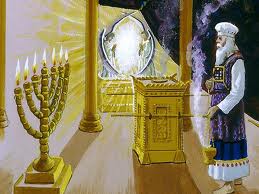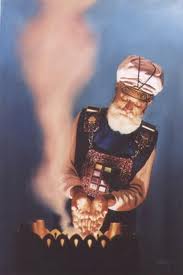
Type Of The Heavenly
Not only the sanctuary itself, but the ministration of the priests, was to "serve unto the example and shadow of heavenly things." Hebrews 8:5. Thus it was of great importance; and the Lord, through Moses, gave the most definite and explicit instruction concerning every point of this typical service. The ministration of the sanctuary consisted of two divisions, a daily and a yearly service. The daily service was performed at the altar of burnt offering in the court of the tabernacle and in the holy place; while the yearly service was in the most holy.
No mortal eye but that of the high priest was to look upon the inner apartment of the sanctuary. Only once a year could the priest enter there, and that after the most careful and solemn preparation. With trembling he went in before God, and the people in reverent silence awaited his return, their hearts uplifted in earnest prayer for the divine blessing. Before the mercy seat the high priest made the atonement for Israel; and in the cloud of glory, God met with him. His stay here beyond the accustomed time filled them with fear, lest because of their sins or his own he had been slain by the glory of the Lord.
The daily service consisted of the morning and evening burnt offering, the offering of sweet incense on the golden altar, and the special offerings for individual sins. And there were also offerings for Sabbaths, new moons, and special feasts.

Every morning and evening a lamb of a year old was burned upon the altar, with its appropriate meat offering, thus symbolizing the daily consecration of the nation to Jehovah, and their constant dependence upon the atoning blood of Christ. God expressly directed that every offering presented for the service of the sanctuary should be "without blemish." Exodus 12:5. The priests were to examine all animals brought as a sacrifice, and were to reject every one in which a defect was discovered. Only an offering "without blemish" could be a symbol of His perfect purity who was to offer Himself as "a lamb without blemish and without spot." 1 Peter 1:19. The apostle Paul points to these sacrifices as an illustration of what the followers of Christ are to become. He says, "I beseech you therefore, brethren, by the mercies of God, that ye present your bodies a living sacrifice, holy, acceptable unto God, which is your reasonable service." Romans 12:1. We are to give ourselves to the service of God, and we should seek to make the offering as nearly perfect as possible. God will not be pleased with anything less than the best we can offer. Those who love Him with all the heart, will desire to give Him the best service of the life, and they will be constantly seeking to bring every power of their being into harmony with the laws that will promote their ability to do His will.
In the offering of incense the priest was brought more directly into the presence of God than in any other act of the daily ministration. As the inner veil of the sanctuary did not extend to the top of the building, the glory of God, which was manifested above the mercy seat, was partially visible from the first apartment. When the priest offered incense before the Lord, he looked toward the ark; and as the cloud of incense arose, the divine glory descended upon the mercy seat and filled the most holy place, and often so filled both apartments that the priest was obliged to retire to the door of the tabernacle. As in that typical service the priest looked by faith to the mercy seat which he could not see, so the people of God are now to direct their prayers to Christ, their great High Priest, who, unseen by human vision, is pleading in their behalf in the sanctuary above.
The incense, ascending with the prayers of Israel, represents the merits and intercession of Christ, His perfect righteousness, which through faith is imputed to His people, and which can alone make the worship of sinful beings acceptable to God. Before the veil of the most holy place was an altar of perpetual intercession, before the holy, an altar of continual atonement. By blood and by incense God was to be approached--symbols pointing to the great Mediator, through whom sinners may approach Jehovah, and through whom alone mercy and salvation can be granted to the repentant, believing soul.
As the priests morning and evening entered the holy place at the time of incense, the daily sacrifice was ready to be offered upon the altar in the court without. This was a time of intense interest to the worshipers who assembled at the tabernacle. Before entering into the presence of God through the ministration of the priest, they were to engage in earnest searching of heart and confession of sin. They united in silent prayer, with their faces toward the holy place. Thus their petitions ascended with the cloud of incense, while faith laid hold upon the merits of the promised Saviour prefigured by the atoning sacrifice. The hours appointed for the morning and the evening sacrifice were regarded as sacred, and they came to be observed as the set time for worship throughout the Jewish nation. And when in later times the Jews were scattered as captives in distant lands, they still at the appointed hour turned their faces toward Jerusalem and offered up their petitions to the God of Israel. In this custom Christians have an example for morning and evening prayer. While God condemns a mere round of ceremonies, without the spirit of worship, He looks with great pleasure upon those who love Him, bowing morning and evening to seek pardon for sins committed and to present their requests for needed blessings.
PP 351-353